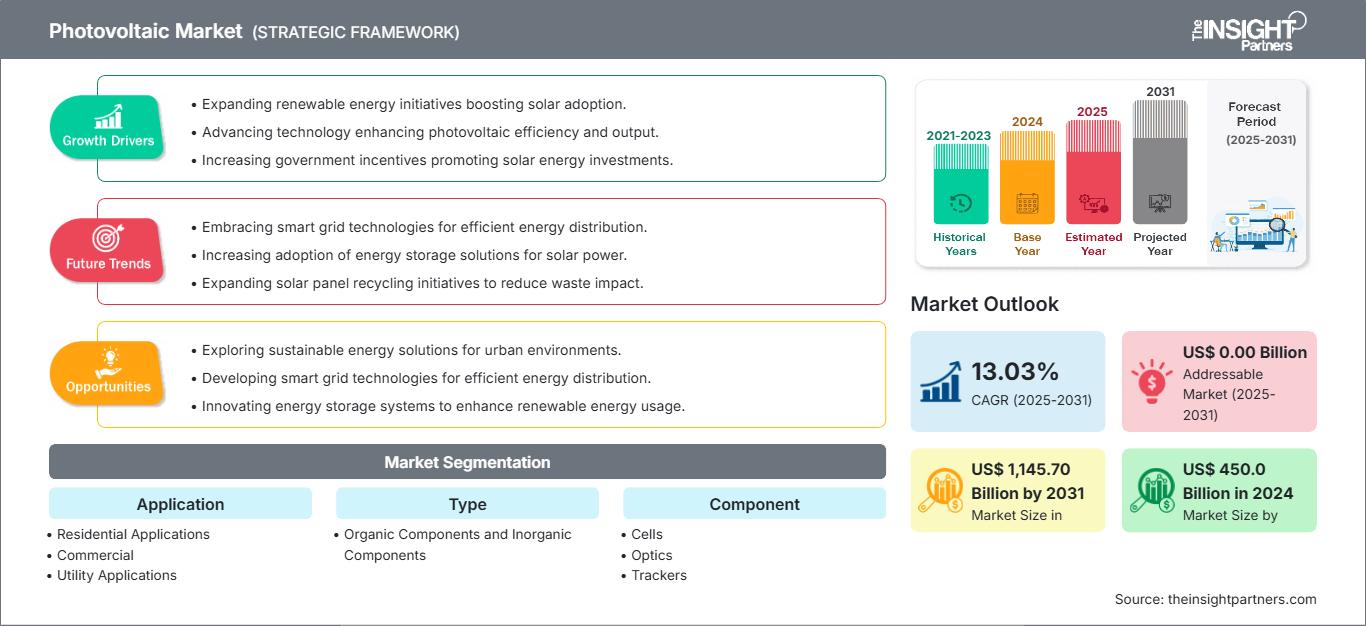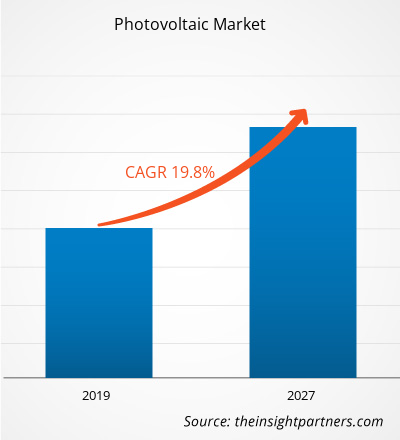光伏市场规模预计将从2024年的4500亿美元增至2031年的11457亿美元。预计2025年至2031年期间,该市场的复合年增长率将达到13.03%。
随着技术的发展和对太阳能光伏技术日益增长趋势的关注,德国和西班牙政府建立了强有力的政策框架,例如明确的国家目标、吸引人的消费激励措施以及促进太阳能技术发展和光伏技术应用的综合计划,从而推动了光伏市场的增长。在亚太地区,各国政府已采取多项举措,以最大限度地降低整体装置的成本,从而最大限度地发挥离网方案在农村电气化中的深远效益,并更加注重可持续的环境条件。此外,中国等一些国家已制定政策,以提高光伏太阳能的生产水平。因此,上述因素正在推动光伏市场的增长。
光伏 (PV) 能源正在快速增长,为经济电力系统的能源平衡做出了重要贡献。这些系统已成为主流发电的成熟技术,并推动着光伏市场的增长。然而,太阳能光伏系统发电量过剩。世界各地的电力供应商都提供净计量服务,即将并网可再生能源系统产生的多余电力返还给电表。这避免了浪费,并在需要时改善了能源分配。与需要电池的独立系统相比,采用电网技术的光伏系统约占装机容量的 99%。无电池并网光伏被认为是一种经济高效的解决方案,且维护成本更低,这促进了光伏产品的普及,从而推动了光伏市场份额的增长。
此外,对于那些正在转向使用太阳能电池板的人们来说,并网光伏系统被认为是满足其全部电力需求的经济高效的选择。此外,独立系统的安装相当繁琐,比光伏并网系统需要更多的资金和空间。因此,光伏并网系统普及率的上升将进一步推动光伏市场的增长。此外,随着人们对可再生能源使用的日益关注以及节能趋势的兴起,并网光伏系统已被证明是一种经济可行的选择。然而,目前其应用范围相当有限,未来几年可能会有所扩大。
您将免费获得任何报告的定制,包括本报告的部分内容,或国家级分析、Excel 数据包,以及为初创企业和大学提供超值优惠和折扣
光伏市场: 战略洞察

-
获取本报告的主要市场趋势。这个免费样本将包括数据分析,从市场趋势到估计和预测。
光伏市场洞察:光伏涂料在太阳能利用中的应用日益广泛
原油价格波动、水电相关的环境问题以及核辐射相关风险,使得满足能源需求的重担转移到太阳能上。技术的进步、对降低安装成本的重视以及光伏技术在住宅应用中的快速应用,都是重新定义光伏技术应用的因素。在太阳能使用日益广泛的时代,太阳能涂料的推出已成为一项了不起的成就。太阳能涂料,俗称光伏涂料,可以涂在任何表面,捕获太阳能并将其转化为电能。这种涂料的成分与悬浮在其中的数十亿颗感光材料相结合,有助于将普通涂料转变为具有超强能量捕获能力的涂料。使用光伏涂料可以有效降低对金属的依赖,并结合pn结二极管原理/热电效应,利用太阳光产生电能。因此,这将推动太阳能的普及,并最终推动光伏市场的增长。Onyx Solar Group LLC等公司正致力于技术发展,专注于研发活动并与研究机构合作开发光伏涂料,从而推动光伏市场的增长。尽管太阳能涂料或光伏涂料技术目前尚处于起步阶段,但在不久的将来可能会获得发展。随着太阳能产业的进步和发展,太阳能涂料极有可能成为一种合理的选择。因此,上述因素正在为光伏市场创造机遇。
光伏市场区域洞察
The Insight Partners 的分析师已详尽阐述了预测期内影响光伏市场的区域趋势和因素。本节还讨论了北美、欧洲、亚太地区、中东和非洲以及南美和中美洲的光伏市场细分和地理分布。
光伏市场报告范围
| 报告属性 | 细节 |
|---|---|
| 市场规模 | US$ 1,145.70 Billion by 2031 |
| 市场规模 | US$ 450.0 Billion in 2024 |
| 全球复合年增长率 (2025 - 2031) | 13.03% |
| 历史数据 | 2021-2023 |
| 预测期 | 2025-2031 |
| 涵盖的领域 |
By 应用
|
| 覆盖地区和国家 |
北美
|
| 市场领导者和主要公司简介 |
|
光伏市场参与者密度:了解其对商业动态的影响
光伏市场正在快速增长,这得益于终端用户需求的不断增长,而这些需求的驱动因素包括消费者偏好的演变、技术进步以及对产品优势的认知度的提升。随着需求的增长,企业正在扩展产品线,不断创新以满足消费者需求,并抓住新兴趋势,从而进一步推动市场增长。

- 获取 光伏市场 主要参与者概述
基于组件的市场洞察
光伏电池由两层或多层半导体薄层组成。光伏电池中最常用的材料是硅。半导体电池在光照下产生电荷,并通过金属触点传导为直流电 (DC)。因此,光伏电池的普及将在预测期内推动全球光伏市场规模的增长。
光伏市场的参与者采用合并、收购和市场举措等策略来保持其在光伏市场中的地位。以下列出了一些主要参与者的进展:
- 2021 年,荷兰皇家壳牌有限公司 (Royal Dutch Shell PLC) 启动了其 25 兆瓦的 Qabas 太阳能发电厂。该项目由超过 88,000 个太阳能组件组成,位于阿曼北部苏哈尔自由区占地 50 公顷的土地上。它每年可减少约25,000公吨的二氧化碳排放。
- 2021年,沙特首个公用事业规模的可再生能源项目——300兆瓦的Sakaka光伏独立发电厂(IPP)由ACWA Power启动,耗资12亿沙特里亚尔。ACWA Power以创世界纪录的电价赢得了该项目,即每千瓦时2.3417美分(每千瓦时8.781哈拉拉)。
- 历史分析(2 年)、基准年、预测(7 年)及复合年增长率
- PEST和SWOT分析
- 市场规模、价值/数量 - 全球、区域、国家
- 行业和竞争格局
- Excel 数据集
近期报告
客户评价
购买理由
- 明智的决策
- 了解市场动态
- 竞争分析
- 客户洞察
- 市场预测
- 风险规避
- 战略规划
- 投资论证
- 识别新兴市场
- 优化营销策略
- 提升运营效率
- 顺应监管趋势






















 获取免费样品 - 光伏市场
获取免费样品 - 光伏市场